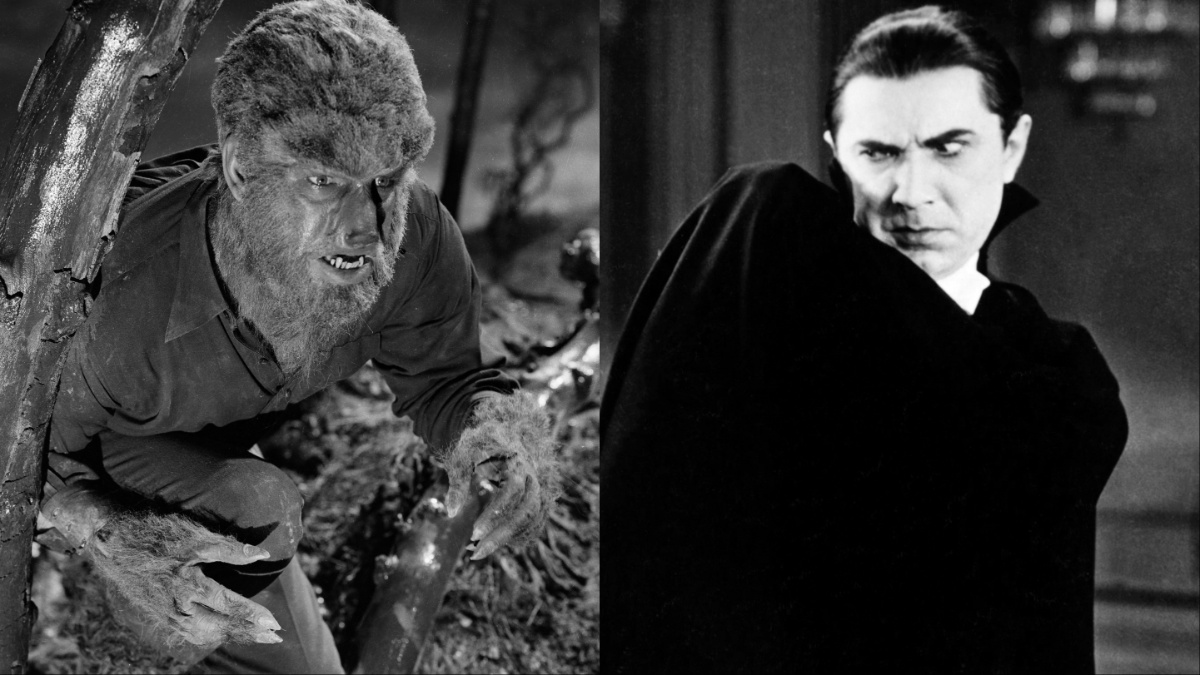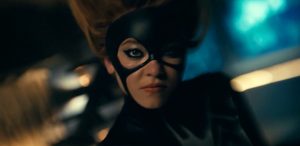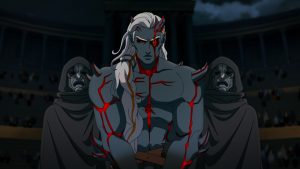
When most folks think of Universal horror, certain images spring to mind. Windswept castles littered with debris and bats; windmills standing alone on a dark and stormy night; vampires, werewolves, and other assorted beasties fleeing into the fog. Despite the Universal Monsters cycle running its original course nearly 80 years ago, its most famous icons—Dracula, Frankenstein’s Monster, the Wolf Man, and the Mummy—remain firmly planted in the pop culture imagination every October.
Much of this is descended from the classics of the 1930s: Dracula, starring Bela Lugosi, Frankenstein and Bride of Frankenstein, starring Boris Karloff and later Elsa Lanchester. Yet while the most famous monster movies hail from the Depression decade—or right after in the case of Lon Chaney Jr.’s horror breakout in 1941’s The Wolf Man—they remained big business up until and through World War II. Well before Marvel, DC, or even Toho’s Godzilla flicks, the first shared cinematic universe belonged to gods and monsters. It’s even probably this slew of wartime programmers produced on a budget that inspired Halloween staples like Bobby Pickett’s “Monster Mash”—a song that seems tailor-made for movies like Frankenstein Meets the Wolf Man (1943), House of Frankenstein (1944), which saw Dracula get in on the action, and the House of Dracula (1945) reunion.
For horror aficionados of a certain sensibility, these ‘40s films can be every bit as enjoyable as the true classics, even if they come from a decidedly lesser vintage. Which is what makes Philip J. Riley’s publication of an unproduced fourth installment in these crossovers, The Wolf Man vs. Dracula, such a fascinating discovery. Apparently unearthed in the garage of golden age Hollywood scribe Bernard Schubert (Mark of the Vampire, The Mummy’s Ghost) more than 40 years after the project was shelved, the abandoned movie could’ve been a one-of-a-kind Universal thriller.
According to Schubert, who passed away in 1988, the film would have been a technicolor spectacle, a first for Universal’s horror cycle unless you count the Claud Rains-starring Phantom of the Opera (1943). Special effects cinematographer David Stanley Horsley (The Killers, Abbott and Costello Meet Frankenstein) confirmed this detail, too, when he spoke with Universal about doing special effects tests for the film’s flying bat sequences. He also said Jack Pierce’s famous Wolf Man makeup design was tested on Chaney in color.
The film obviously did not happen, but the script remains, as do claims based on Schubert and Horsley’s own memories that it would have been a direct sequel to Frankenstein Meets the Wolf Man, with the plan being to reunite Chaney and Bela Lugosi. After all, the two played, respectively, the werewolf and Frankenstein Monster in that earlier chiller—only now Lugosi would finally reprise his signature role as Dracula 13 years after donning the cape for the first time onscreen in the Tod Browning classic.
I have major doubts about that chronology, including whether Lugosi was ever seriously considered to play the vampire in this movie, but the script itself is a remarkable relic on a road not taken into Universal’s perennially dark woods.
How the Monsters Came Back
If The Wolf Man vs. Dracula had been made, likely the most impressive element would be the first, prologued sequence. Most of the latter-period monster mash films are defined by evocative and spooky tablesetters—the grave robbers getting more than they bargained for when they remove the wolfsbane in the Talbot crypt; a mad scientist played by Boris Karloff escaping with a deranged hunchbacked assistant out of a dungeon—and The Wolf Man vs. Dracula would be no different, in technicolor or otherwise.
Beginning on the sight of disheveled and skittish European villagers (are there really any other kind in these movies?), The Wolf Man vs. Dracula story starts on a quasi-mystery when local authorities discover the bodies of two young people in the wilderness far from town. One of them has decomposed to the state of a skeleton, even as her arms wrap firmly still around the remains of her presumed lover: a strapping big fellow who appears to be in the bloom of life despite having been deceased in the ground for some time, a grim fact indicated by the deceased Romani girl’s remains and the vines growing through his clothes.
Audiences would instantly know this is Lawrence Talbot, Lon Chaney Jr.’s doomed antihero on his good days. Unfortunately, this evening is not one of those good days. In fact, when he’s unearthed the full moon is kissing his forehead. Also, in a bit of bad news for the nearby town, the local medical examiner is a go-getter. Incredibly, he assembles that very night journalists from across Europe to report on his medical miracle: a man who has been in “suspended animation” for five years, and who can be resurrected… provided they remove the silver bullet lodged beside his heart.
The experiment is of course a success. But in a sequence that would have been a plum scene geared toward Lon Chaney Jr.’s strengths, the dead man is hardly grateful when he wakes up.
“[The doctor] does not see the patient’s eyes slowly open,” wrote Schubert. “At first their expression is vague, uncomprehending. Then as they become accustomed to the light, they focus and shift to the doctor and slowly a look of cold hatred comes into them. In a voice that is barely audible, but filled with cold venom he says: … ‘You are a fool!’”
It is all very theatrical and part and parcel for Chaney. It also gives us confirmation that The Wolf Man vs. Dracula was written as a sequel to House of Frankenstein, not Frankenstein Meets the Wolf Man. After all, Frankenstein Meets the Wolf Man ended with Talbot’s furry alter-ego and the Monster washed away after the destruction of a dam. Conversely, House of Frankenstein is the one which concluded with the Wolf Man being gunned down by a “gypsy girl” who loved him (Anne Gwynne). She even wrapped her arms around him in her final breaths. Furthermore, the Wolf Man vs. Dracula script is dated May 29, 1944, the same month that House of Frankenstein wrapped production on the Universal backlot.
The importance of the chronology for when the movie would have been made will become clearer later, but in terms of the opening, it sets up a properly macabre introduction. Because after Talbot is brought back from the dead, the doctor leaves him alone with an intern who is ordered to concoct a sedative that will calm Talbot’s nerves. While it is brewing, old Larry simply asks when the next full moon is.
“I believe it’s full tonight,” the intern responds while craning his head toward the window. “You can’t see it at the moment — it’s behind a cloud.” In a beat Chaney would’ve known too well how to play, Talbot resigns himself to damnation, staring helplessly toward the window with tears in his eyes as the moonlight slowly drifts between the bars and a familiar transformation occurs… only this time we see it strictly from the intern’s point-of-view as he comes into the room, entwined between shadow and moonlight, to find something growling at him. It doesn’t end well for the white coat.
A True Wolf Man Sequel
If it wasn’t already clear from that protracted opening, The Wolf Man vs. Dracula was intended to place a lot more emphasis on the furry side of the equation. In Riley’s screenplay book, screenwriter Schubert is quoted as saying, “Lon Chaney Jr. was the big horror star at Universal at that time. Curt Siodmak wrote most of his films and the Wolfman character was his baby.”
While Siodmak did not have a hand in this unproduced script, nor any of the Wolf Man-adjacent films released after 1944, The Wolf Man vs. Dracula follows much the same structure of Siodmak’s Frankenstein Meets the Wolf Man, a film very much favored toward Chaney’s strengths at playing the affable (and sometimes unintentionally predatory) yankee in a strange land—before like a doomed addict his vice consumes him again. As with Meets Frankenstein, vs. Dracula would be about Larry’s desire to find a new way to kill himself. And this time, that quest would bring him to the far flung reaches of Transylvania.
It is there that Larry would find an honest hangman he would pay to shoot him with a silver bullet. Admittedly this is a pretty convoluted solution for suicide, one which requires Schubert to tweak the werewolf lore yet again in these Universal movies, this time by having Larry explain that a werewolf can only be killed with a silver bullet after he transforms into a wolf (a convenient and newly invented excuse for not doing it yourself, eh?).
Yet Larry’s journey to “Bohemia,” as the script describes it, also brings him into contact with the hangman’s daughter, Yvonne. A “plain” child of the respected but feared local hangman, Anatole, Yvonne only has one creepy suitor when Larry calls on her father. But she is so glum about being forced by papa to marry the suitor that she’s contemplating running away. Upon hearing this tale of woe, old Lawrence—the guy who in a previous movie was pointing telescopes into local girls’ bedrooms—stumbles on a funny notion.
“You don’t really want to leave your father do you?” Larry asks. She shakes her head. “If there was only some way to get rid of our friend [the other suitor], you’d…” He trails off until she asks what he’s thinking about. “Oh, one idea just occurred to me…” What sort of idea? “Oh, just a wild one — too crazy even to talk about.”
In the next scene, Larry and Yvonne return from town to announce they’ve gotten married. Better still, he bought her a nice dress and some makeup, and it turns out she’s gorgeous!
It’s a pretty strange life move for a guy who just secretly asked her father in the previous scene to put a silver bullet in his head. But as Larry reveals to Anatole, that’s the point. They’ve got three weeks until the next full moon, and in that time Anatole can decide to believe his new son-in-law is a werewolf and be ready to put him down or, presumably, be prepared to see his daughter and himself torn to shreds by the Wolf Man.
It’s certainly some kind of plan, yet seems contrived by a screenwriter who wants to pave the way for Larry to have a sweeping romance, or at the very least the type you might see in a B-movie Western. There are indeed multiple scenes of Larry helping Yvonne and Anatole farm and tend the land, as well as riding the wagon into town, on which Yvonne sings “a merry little folk song” in Larry’s arms. These scenes are meant to establish Larry is truly falling in love with his new wife and coming to fear, as much as Anatole, what will happen at the next full moon if father-in-law doesn’t craft a silver bullet.
Of course there is the problem of the jilted suitor as well…
A Not So Great Dracula Sequel
One detail left out from above is who the third wheel in the courtship is: Count Dracula.
That’s right the Father of Evil, the corruptor of the innocent, and the maestro of the Children of the Night is… that creepy old guy trying and failing to buy himself a young bride. It begins poorly with Dracula introduced in silhouette as he haggles essentially over a price from her father Anatole.
“My dear Anatole, let me be the judge of that,” Dracula says when Anatole suggests he seek a bride from the aristocracy. “Properly groomed, Yvonne would be a credit to any class.” At least the script later confirms that on this subject the Count remains a man of good… taste.
Nevertheless, it’s a strange dynamic for the vampire who was once depicted as stealing away into the bedchambers of young women in the 1931 Dracula movie, if not attacking them on the street, to now beg for the chance to marry into a peasant family. What happened to the Transylvanian brides he left unharmed in the 1931 movie is also a mystery. But rest assured, this is intended to be a quasi-sequel to that film, as Dracula speaks of being descended from the infamous ancestor accused by locals of being a vampire. That’s all superstition, of course, and he insists he’s returned from years abroad in London to set the rumors to rest.
If this were really to mark Lugosi’s return to the cape as the lore around The Wolf Man vs. Dracula suggests, it would be a pretty pitiful reprisal. For better or worse, though, this seems unlikely. Whether this movie had been made after Frankenstein Meets the Wolf Man or House of Frankenstein, Lugosi was in poor standing at Universal. The studio, perhaps unfairly, blamed the then 61-year-old for an incomprehensible performance in Frankenstein Meets the Wolf Man as the flat-topped monster. But it was not Lugosi who made the choice of giving the Monster ludicrous dialogue for his thick Hungarian accent, or then chose to cut all of those lines in post-production, rendering the performance totally incomprehensible.
There is also the unconfirmed, but plausible, rumor that Universal top brass were angered by Lugosi appearing in Columbia Pictures’ Return of the Vampire (1943), a movie where Lugosi played Dracula in all but name. That film even had a werewolf, Universal’s marquee monster in the WWII years. So Lugosi was out at Universal, as indicated by the flagrant miscasting of John Carradine as the Count in House of Frankenstein. It’s a role Carradine played more times onscreen than Lugosi, but never a tenth as well. Carradine would be the studio’s choice again in 1945’s House of Dracula, the movie Universal made instead of The Wolf Man vs. Dracula. Allegedly the only reason Lugosi finally got to reprise the part in Abbott and Costello Meet Frankenstein (1948) is because the directors insisted the studio had to bring Lugosi back for the comic sendup.
If the role of Dracula in this unmade Universal Monsters crossover would have almost certainly been played by Carradine, why is the legend that it was conceived for Lugosi? Perhaps Schubert and Horsley misremembered the chain of events given they were only asked about the project at the end of their lives 30 or 40 years later. Or perhaps they were mistaken. Admittedly, some lines in the screenplay seem written in a way favoring Lugosi’s long and distinct cadence.
They fare ultimately better as the film goes on too. Dracula eventually becomes more menacing when he forces Yvonne to wear a string of pearls that seemingly have some supernatural power. He later comes to her that night when she places them on her neck in the bedroom, but is thwarted in his intentions by her blasted crucifix. Later, after he discovers Larry married her, the Count goes to extraordinary lengths to not only seduce Yvonne but also humiliate Larry, including by transforming into a wolf and killing local villagers before the full of the moon, causing Anatole to suspect Larry is either a werewolf or a madman on any night of the year.
His most elaborate scheming, however, is getting Lawrence and Anatole to ultimately come crawling to him for help. In addition to being a long lost relative of the infamous Dracula, this new neighborly Count poses as a doctor of psychology and obscure diseases who might be able to cure Talbot. The fiend lures Lawrence by day to Castle Dracula’s library and a medieval book titled Supernatural Manifestations: Demons, Vampires, Werewolves.
It is of course a long ruse, and on the last night before the full moon, Dracula comes in the wee small hours of the morning to a desperate Larry, who now wants to live again. Dracula gets him to agree to give him Yvonne’s crucifix as a fee for his services. A crazed Talbot acquiesces to the mad request, but as soon as the crucifix is off the sleeping young wife’s throat, Dracula vanishes into a mist… and a bat.
Oh yes, there was an elaborate special effect intended to be the centerpiece of The Wolf Man vs. Dracula: a giant mechanical bat capable of dive-bombing its victims and feeding on their throats. It even gets a mouthful of sleeping Yvonne’s blood, using that to cast a spell that lures her to Castle Dracula the next day…
The Monster Mash Not Taken
In its grand finale, The Wolf Man vs. Dracula sees all roads lead to Castle Dracula. Larry goes there in search of Yvonne, the police and Anatole go in search of Larry, having become convinced that Larry is a madman responsible for a series of grisly lycanthrope-like murders in the region (only one is shown on screen, with the vampire-wolf chasing Larry and Yvonne after slaughtering a neighbor).
Curiously, the end of the movie doesn’t really feature the Wolf Man versus Dracula, at least in the way you would like. Before the full moon rises, a humanoid Larry is able to find Yvonne in the crypt and break Dracula’s thrall over her. As they attempt to escape into the nearby cemetery and woods, Dracula awakens and takes the form of that giant bat and continues dive-bombing them until Larry is able to kill it by shoving a tombstone in the shape of a crucifix through its heart. Alas, by this time it is too late for Larry to find any help. The full moon crests after Dracula is dead, and as a werewolf, the other beastie begins stalking his wife through Castle Dracula! (Before turning, Larry even saw the pentagram in Yvonne’s palm!)
By then, three constables and Anatole have arrived, helping raise the bodycount as the Wolf Man takes out each of the coppers one by one, before working his way to Anatole and Yvonne who have wound up back in the crypt. But the last moment before the werewolf takes his daughter, Anatole shoots the Wolf Man with a silver bullet he reluctantly made. At last a true believer, Anatole sees the beast transform back into the man.
“You mustn’t [cry] Yvonne,” Larry tells his wife. “Your father only did what I asked him to do. You brought the only beauty in my life I have ever known — even if it was for a short time.” Turning to dad, he adds, “Thanks — friend. Now I can rest in —.” His eyes, plus the credits, close in before he can finish the last sentence.
It ultimately would have been a pretty schlocky movie, but probably no more so than either House of Frankenstein or House of Dracula. And as a Universal Monsters-loving kid who grew up enjoying both of those movies without discrimination, I imagine my childhood self would’ve devoured this too. In some ways, it’s stronger than either House movie, because like Frankenstein Meets the Wolf Man, it has an actual narrative backbone as a Wolf Man sequel designed to make Lon Chaney Jr. look good. Conversely, the Houses were always disjointed vignettes and set-pieces thrown together.
Still, in some ways it might be best that we got House of Dracula instead of The Wolf Man vs. Dracula. For starters, as chintzy as House of Dracula is, it features a delightful performance by Onslow Stevens as Dr. Edlemann, the kindly scientist who cures Larry Talbot of werewolfism before being corrupted into evil by consuming the blood of Dracula.
Furthermore, House of Dracula is the only Wolf Man movie wherein poor Larry gets a happy ending. And the scene where Talbot realizes the full moon has risen and he’s still Larry features some of the subtlest and most heartfelt acting in Chaney’s career. He was an actor who knew all too well what it was like to carry around a demon… and perhaps dream of a night without.
At the end of the day, we also did get a Wolf Man versus Dracula movie of sorts in Abbott and Costello Meet Frankenstein. Yep, it’s remembered as a classic for seeing Bud Abbott and Lou Costello bouncing off Universal’s most famous Monsters, but one of the movie’s great strengths is that the Monsters play it straight. Chaney’s still earnest and pitiful as the re-cursed Wolf Man, and Bela Lugosi is finally back in the cape. He proves as malevolent as ever, to, luring Lenore Aubert into the ranks of the Undead and fantasizing about removing Costello’s brain from his body.
Finally, that film actually sees the Wolf Man and Dracula in the way we like them: with the iconic actors in the costumes and makeup, duking it out to the bitter end. The Wolf Man vs. Dracula is a fascinating road not taken, but we still got there all the same.
The post The Wolf Man vs. Dracula: Inside an Unmade Universal Monsters Classic appeared first on Den of Geek.



